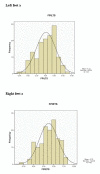The paediatric flat foot proforma (p-FFP): improved and abridged following a reproducibility study
- PMID: 19691841
- PMCID: PMC2734539
- DOI: 10.1186/1757-1146-2-25
The paediatric flat foot proforma (p-FFP): improved and abridged following a reproducibility study
Abstract
Background: Concern about a child's flat foot posture is a common reason for frequent clinical consultations for an array of health care and medical professionals. The recently developed paediatric flatfoot clinical-care pathway (FFP) has provided an evidence based approach to diagnosis and management. The intra and inter-rater/measurer reliability of the FFP has been investigated in this study.
Methods: From a study population of 140 children aged seven to 10 years, a sample with flat feet was identified by screening with the Foot posture index (FPI-6). Subjects who scored >/= 6 on the FPI-6 for both feet became the study's flat foot sample. A same subject, repeated measure research design was used for this study which examined the reliability of the FFP in 31 children aged seven to 10 years, as rated by three examiners.
Results: Approximately half of the items of the FFP showed less-than-desirable inter-rater reliability, arbitrarily set at the conventional 0.7 level (intra-class correlations). Removal of the unreliable items has produced a shorter; more relevant instrument designated the paediatric flat foot proforma (p-FFP).
Conclusion: The p-FFP is a reliable instrument for the assessment and resulting treatment actions for children with flat feet. Findings indicate that the simplified p-FFP is a reproducible instrument for the clinical assessment of flat foot in mid-childhood.
Figures



References
-
- Sullivan JA. Pediatric flatfoot: evaluation and management. Journal of the American Academy of Orthopaedic Surgeons. 1999;7:44–53. - PubMed
-
- Suzuki N. An electromyographic study of the role of muscles in arch support of the normal and flat foot. Nagoya Medical Journal. 1972;17:57–79. - PubMed
-
- Tareco JM, Miller NH, MacWilliams BA, Michelson JD. Defining flatfoot. Foot & Ankle International. 1999;20:456–460. - PubMed
-
- Tax HR. Flexible flatfoot in children. Journal of the American Podiatry Association. 1977;67:616–619. - PubMed
-
- Alakija W. Prevalence of flat foot in school children in Benin City, Nigeria. Tropical Doctor. 1979;9:192–194. - PubMed
LinkOut - more resources
Full Text Sources

